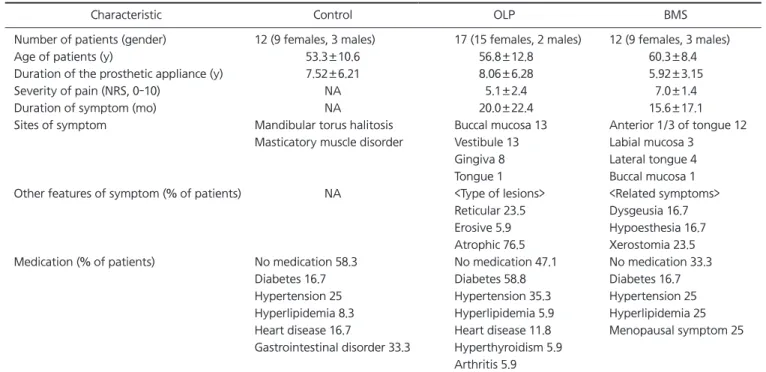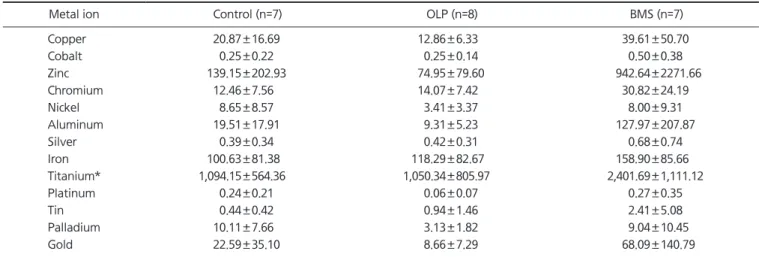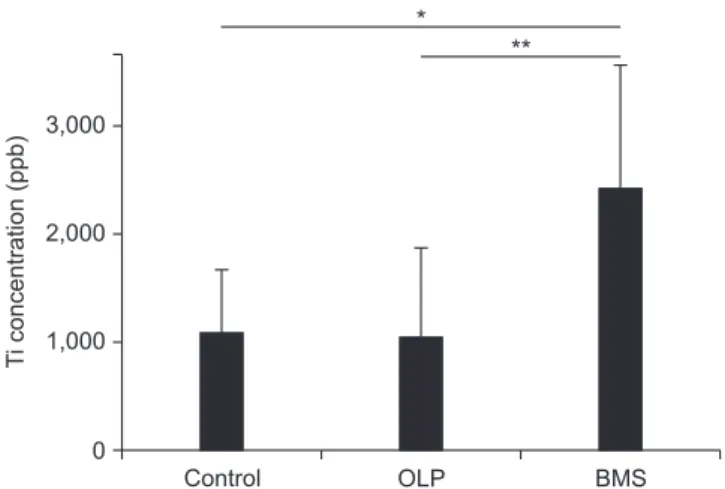pISSN 2288-9272 eISSN 2383-8493 J Oral Med Pain 2017;42(4):102-108 https://doi.org/10.14476/jomp.2017.42.4.102
Titanium Ions Released from Oral Casting Alloys May Contribute to the Symptom of Burning Mouth Syndrome
Yang Mi Park 1 , Kyung-Hee Kim 2 , Sunhee Lee 1 , Hye-Mi Jeon 3 , Jun-Young Heo 1 , Yong-Woo Ahn 1 , Soo-Min Ok 1 , Sung-Hee Jeong 1
1 Department of Oral Medicine, School of Dentistry, Pusan National University, Dental Research Institute, Institute of Translational Dental Sciences, Yangsan, Korea
2 Department of Oral Medicine, Busan Paik Hospital, Inje University College of Medicine, Busan, Korea
3 Dental Clinic Center, Pusan National University Hospital, Busan, Korea
Received October 31, 2017 Revised November 24, 2017 Accepted November 27, 2017
Purpose: Many metal ions released from dental casting alloys have been reported to influence the intraoral symptoms of oral lichen planus (OLP) and burning mouth syndrome (BMS). The aim of this study was to investigate the relationship between salivary metal ion levels and the prosthetic duration as well as to evaluate the time-dependent morbid effects of metal ions in OLP and BMS patients.
Methods: Three study groups consist of the following subjects respectively: 17 OLP patients, 12 BMS patients, and 12 patients without oral symptoms. The salivary concentrations of 13 metal ions (copper, cobalt, zinc, chromium, nickel, aluminum, silver, iron, titanium [Ti], platinum, tin, palladium, and gold) were measured by Laser Ablation Microprobe Inductively coupled Plasma Mass Spectrometry.
Results: The Ti ions had statistically significant differences among the groups with a pros- thetic duration of less than 5 years. There were no significant differences between all ion levels among the groups wearing dental cast alloys for over 5 years. In the BMS group, the level of Ti ions in patients with prosthetic restorations less than 5 years old were significantly high (p<0.05).
Conclusions: In the BMS group, 3-60 months during which salivary Ti levels were higher were matched with the duration of burning symptoms (15.6±17.1 months). Furthermore, Ti ions were statistically high in the oral cavity of BMS patients fitted with dental casting alloys for 5 years. These results suggest that Ti ions released from dental implants and oral prostheses could attribute to burning sensation of BMS.
Key Words: Burning mouth syndrome; Metals; Saliva; Titanium
Correspondence to:
Sung-Hee Jeong
Department of Oral Medicine, School of Dentistry, Pusan National University, 49 Busandaehak-ro, Mulgeum-eup, Yangsan 50612, Korea
Tel: +82-55-360-5242 Fax: +82-55-360-5234 E-mail: drcookie@pusan.ac.kr This study was supported by a Clinical Research Grant, Pusan National University Dental Hospital (2017).
JOMP Journal of Oral Medicine and Pain
Copyright Ⓒ 2017 Korean Academy of Orofacial Pain and Oral Medicine. All rights reserved.
CC


